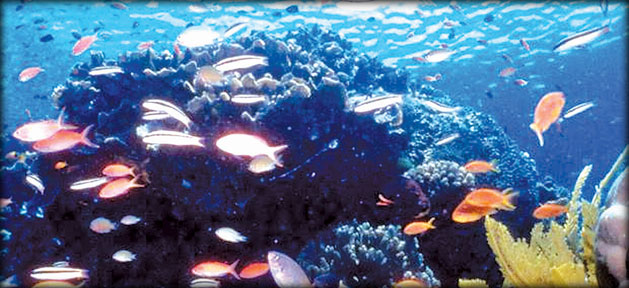The world's largest living organism has shrunk by about half over
the past
Thirty years as a result of climate change, ocean acidification,
pollution and crown-of-thorns starfish, which prey on coralKathy Marks
The spring spawning of coral on the Great Barrier Reef is a grand
affair, with vast expanses of the Pacific Ocean turning red as millions
of sperm and eggs are released, in a spectacle that is visible from
space.
Last month, divers and snorkellers marvelling at the event were
joined by scientists with a deadly serious purpose: to harvest billions
of sperm and eggs, and then freeze them, in an effort to save corals in
the World Heritage-listed reef from extinction.
 |
|
Sperm and cells from
eight species of coral from the reef have already been
frozen and stored |
The world's largest living organism has shrunk by about half over the
past 30 years as a result of climate change, ocean acidification,
pollution and crown-of-thorns starfish, which prey on coral. Some of its
400 or so species are endangered or threatened, and marine biologists
fear they could soon be wiped out. The establishment of a gene bank,
using human fertility techniques, is a bold response by scientists
seeking to conserve the reef, which runs for 1,600 miles off the
Queensland coast.
"We create a coral fertility clinic and we put them [the sperm and
embryonic cells] in a bank, to hold them for now, but to use them in the
future," Mary Hagedorn, from the US's Smithsonian Institution, said. Dr
Hagedorn, a marine biologist who perfected the techniques while working
with coral in Hawaii, is liaising with Australian colleagues to deploy
those techniques in the cause of conservation. Researchers from the
Australian Institute of Marine Science helped to gather samples for the
DNA
bank, which has been set up at Western Plains Zoo in the town of
Dubbo, in the New South Wales outback, 250 miles from the sea.
The project is akin to a captive breeding program for endangered
animals. If all goes according to plan, the genetic material will be
thawed and used to grow new coral which will then be reintroduced into
"the wild" - transplanted back into the ocean - to help restore and
repopulate damaged reefs.
Some of the samples will be used for research aimed at improving
coral's resilience and ability to adapt to changing conditions, while
some will remain in storage indefinitely - for hundreds, or even
thousands, of years. Dr Hagedorn told the Townsville Bulletin that the
gene banks - there are plans to set up a second bank in Townsville -
were "like arks", with at-risk coral species identified and preserved
for posterity.
Sperm and cells from eight species have already been stored in the
Dubbo bank, which is supervised by a team headed by Rebecca Spindler.
"We know the Great Barrier Reef is in deep, deep trouble," said Dr
Spindler. "We will never have as much genetic diversity again on the
reef as we do right now. This is our last opportunity to save as much as
we possibly can."
Like other reefs around the world, the Great Barrier Reef is
threatened by climate change, with a warmer ocean making it more
vulnerable to disease and to "bleaching" - the process where corals
expel the colourful algae which they rely on for food, and which can
lead to them dying. Coral growth is also being inhibited by ocean
acidification, caused by rising carbon dioxide.
The reef - which actually consists of nearly 3,000 individual reefs -
is also being eroded by pollution caused by agricultural and industrial
run-off, and by the crown-of- thorns starfish. Some of the latter, which
devour their size in coral cover every day, weigh up to 80 kilos.
Along the Queensland coast, industrial development - particularly
dredging, carried out to enable large vessels to enter ports - presents
another threat. The federal Environment Minister, Greg Hunt, is about to
rule on an application to dredge at Abbott Point, in north Queensland,
in order to expand the port there and increase coal exports.
Dr Hagedorn has already cryogenically preserved coral sperm and
embryonic cells in Hawaii (whole eggs cannot be frozen). "We put them
into cryo-tubes, and then we float them on a little lake of liquid
nitrogen that freezes them at about 20 degrees per minute, down to minus
196 [Celsius]," she told Australia's ABC radio. "And then we immerse
them in liquid nitrogen and then put them in a dry shipper [container]."
Researchers plan to use the Marine Science Institute's new "Sea
Simulator" - a high-tech aquarium which can mimic the sea's physical
conditions, including temperature and water quality - as a nursery
ground for rearing juvenile corals, and to test ways of reintroducing
them to the reef.
Although cyro-preservation has been around since 1950, when the
British biologist Christopher Polge produced chicks from eggs fertilised
with frozen sperm, each species requires different techniques. Dr
Spindler hopes to grow in-vitro reefs which can be used to re-seed wild
populations.
Western Plains Zoo already houses Australia's main wildlife
reproductive laboratory.
- The Independent |

